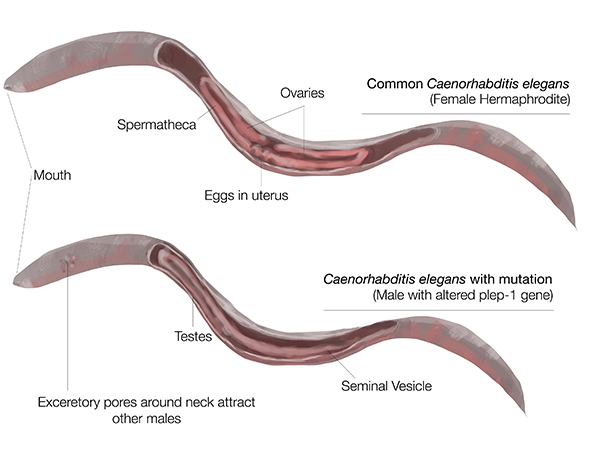Researchers find male-on-male worm action is result of genetic variation

An NYU study has proved that due to a certain gene, male nematode worms are attracted to one another.
October 14, 2015
An NYU research group of both postgraduate students and faculty found that among tiny nematode worms known as caenorhabditis elegans, a variation in a single gene makes male worms attract other male worms.
Led by postdoctoral student Luke Noble at NYU’s Center for Genomics & Systems Biology, the research team made significant discoveries regarding the genetic molecules of the worm and identified a specific gene variation as a cause of the male worms’ behavior.
“We found that a single change in a single gene (plep-1) explains much of the variation in male-male copulatory attraction under laboratory conditions,” Noble said.
Noble’s team focused on C. elegans worms, which, due to their unique mating habits, constitute an effective model to study biological findings regarding sexual signaling behavior on a larger scale.
In nature, the ‘female’ worms are actually self-fertilizing hermaphrodites and the males are next to nonexistent. After observing the behavior of C. elegans worms, Noble and his team have found that the male worms that are homozygous to the plep-1 gene have a tendency to attract each other and mate.
Although it’s unlikely that the males meet and mate in nature, Noble and his team were able to to create the scenario in a lab, finding that males with the necessary gene enjoy plugging excretory pores of other males. Noble explained the importance of sexual behavior in determining the identity of most species in the biological world.
“Sex is advantageous for adapting to changing environmental conditions, and for avoiding inbreeding depression, but it comes with significant costs,” Noble said.
Noble added that in mating with their own gender, males end up compromising their reproductive ability and reducing their life expectancy.
“For tiny worms that hitchhike between patchy habitats it seems that doing away with the need to find a mate can sometimes be more important, and we think that the genetic variation we found in plep-1 has accumulated in C. elegans populations because of this change in mating system,” Noble said.
Noble and his team started the study out of an interest in how species, populations and individuals vary. Through classical genetic mapping techniques, modern DNA sequencing and a powerful experimental system, researchers today are able to pinpoint the genetic basis of almost all species and can analyze highly dynamic traits.
Matthew Rockman, an Associate Professor of Biology who worked alongside Noble, explains the gene discovery came out of a desire to understand how and why these male worms were attracted to other males.
“This research project started with the observation that males vary in their behavior, and from that simple start we mapped the genetic variant that accounts for much of the variation,” Rockman said.
CAS sophomore Anouck Geday feels said she is inspired by the research and intrigued by the potential implications, hoping that these animal studies will also contribute to future human behavioral studies.
“The fact that we know this much information about animal behavior gives me hope for my own future research of human behavior,” Geday said.
Though the findings are specific to C. elegans worms, the researchers hope that their study and its conclusions will lead to more important scientific discoveries in the future.
“Genes are very similar among species, so genetic discoveries in worms can — and in the past have — shed light on molecular function and variation across the diversity of life,” Rockman said.
Email Ludovica Grieco at [email protected].

























































































































































